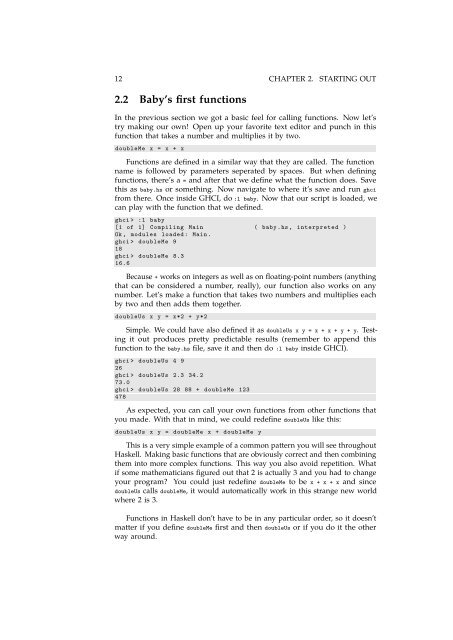Create successful ePaper yourself
Turn your PDF publications into a flip-book with our unique Google optimized e-Paper software.
12 CHAPTER 2. STARTING OUT<br />
2.2 Baby’s first functions<br />
In the previous section we got a basic feel for calling functions. Now let’s<br />
try making our own! Open up your favorite text editor and punch in this<br />
function that takes a number and multiplies it by two.<br />
doubleMe<br />
x = x + x<br />
Functions are defined in a similar way that they are called. The function<br />
name is followed by parameters seperated by spaces. But when defining<br />
functions, there’s a = and after that we define what the function does. Save<br />
this as baby.hs or something. Now navigate to where it’s save and run ghci<br />
from there. Once inside GHCI, do :l baby. Now that our script is loaded, we<br />
can play with the function that we defined.<br />
ghci > :l baby<br />
[1 of 1] Compiling Main ( baby .hs , interpreted )<br />
Ok , modules loaded : Main .<br />
ghci > doubleMe 9<br />
18<br />
ghci > doubleMe 8.3<br />
16.6<br />
Because + works on integers as well as on floating-point numbers (anything<br />
that can be considered a number, really), our function also works on any<br />
number. Let’s make a function that takes two numbers and multiplies each<br />
by two and then adds them together.<br />
doubleUs x y = x*2 + y*2<br />
Simple. We could have also defined it as doubleUs x y = x + x + y + y. Testing<br />
it out produces pretty predictable results (remember to append this<br />
function to the baby.hs file, save it and then do :l baby inside GHCI).<br />
ghci > doubleUs 4 9<br />
26<br />
ghci > doubleUs 2.3 34.2<br />
73.0<br />
ghci > doubleUs 28 88 + doubleMe 123<br />
478<br />
As expected, you can call your own functions from other functions that<br />
you made. With that in mind, we could redefine doubleUs like this:<br />
doubleUs x y = doubleMe x + doubleMe y<br />
This is a very simple example of a common pattern you will see throughout<br />
Haskell. Making basic functions that are obviously correct and then combining<br />
them into more complex functions. This way you also avoid repetition. What<br />
if some mathematicians figured out that 2 is actually 3 and you had to change<br />
your program? You could just redefine doubleMe to be x + x + x and since<br />
doubleUs calls doubleMe, it would automatically work in this strange new world<br />
where 2 is 3.<br />
Functions in Haskell don’t have to be in any particular order, so it doesn’t<br />
matter if you define doubleMe first and then doubleUs or if you do it the other<br />
way around.



